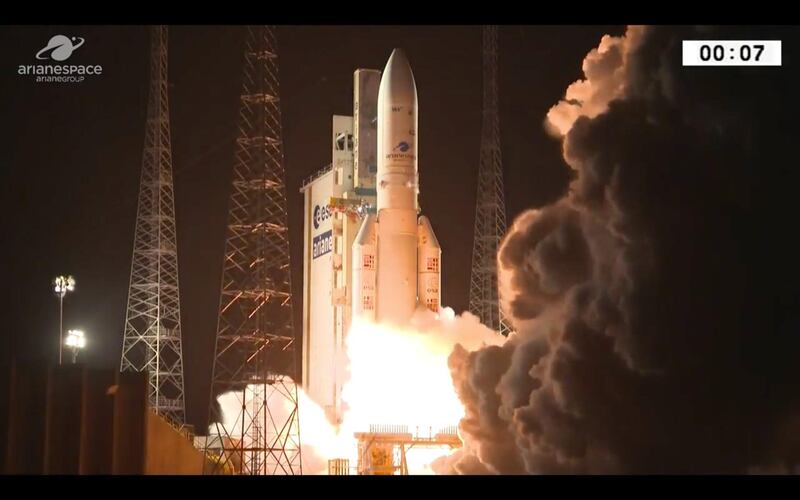During a confusing night, it appears that the UAE’s latest satellite, Al Yah 3, has been successfully launched into orbit despite contact being lost with the Ariane 5 that was carrying it into space from the Ariane Launch Complex in Kourou, French Guiana.
Initially the launch had looked like an unqualified success – the Ariane rocket took off exactly on time, and while the craft was within eyesight nothing appeared to be going wrong. Telemetry provided by Arianespace appeared to show that everything was continuing apace, apparently showing that the other satellite on board, SES-14, had been successfully deployed.
However, the first sign that something was awry came when, at the 35-minute stage, the data being received by mission control – where Dr Mohamed Nasser Al Ahbabi, director general of the UAE Space Agency and members of his team were on hand to monitor proceedings – showed that Al Yah 3 had not been launched.
After a few minutes, the live feed from Arianespace was cut, and 30 minutes later, Stephane Israel, Arianespace’s chief executive, said “We have had an anomaly on this launch”.
Mr Israel reported that controllers received the final piece of telemetry from the Ariane 5 shortly after ignition of the second stage's HM7B engine, which occurred around 9 minutes after lift-off.
Within another 15 minutes, Mr Israel released a fuller statement.
“Ladies and gentlemen, I come to give you some information because we have had an anomaly on this launch. Indeed, we lost contact with the launcher a few seconds after ignition of the upper stage.
“At that time, we can consider that the upper composite and the satellite as being [inaudible]. But as I said, we lost contact. Up to now, our customers do not have contact with the satellite. We need now some time to know if they have been separated, and where they are exactly, to better analyse the consequences of this anomaly.
“I want to present my deepest excuses to our customers, who have entrusted us one more time. We know that there is no launch with no risk. We know that launch is always difficult, and tonight Ariane 5 has had an anomaly, so let’s take time now to better understand the situation of the satellites.
“Arianespace, in full transparency, will come back to you to provide you with some more information as soon as we have them. I apologise on behalf of Arianespace.”
But then there was another twist in the proceedings, as Arianespace released yet another statement, this time claiming a successful launch for the two satellites.
“Both satellites were confirmed separated, acquired and they are on orbit,” Arianespace said
In their updated statement the company said a tracking station in Brazil was unable to track the craft shortly after ignition of the rocket's upper stage.
“A few seconds after ignition of the upper stage, the second tracking station located in Natal, Brazil, did not acquire the launcher telemetry. This lack of telemetry lasted throughout the rest of powered flight. Subsequently, both satellites were confirmed separated, acquired and they are on orbit. SES-14 and Al Yah 3 are communicating with their respective control centres. Both missions are continuing,” the statement said.
Since it was founded in 1980, Arianespace has put more than 550 satellites into orbit including for Europe’s Galileo GPS system.






